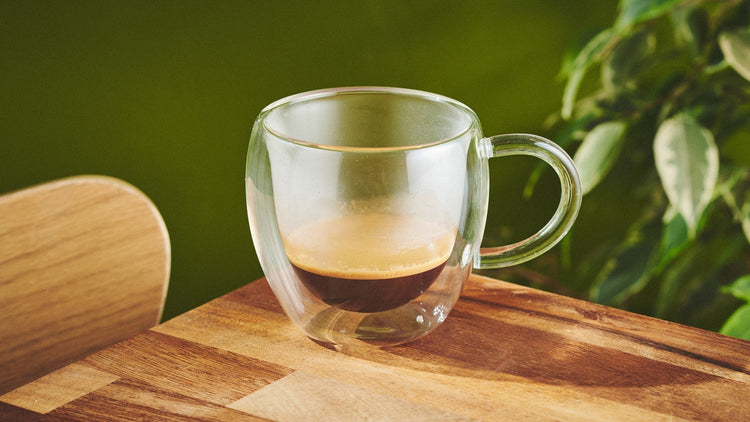What is espresso?

Everything you need to know about the strongest, most complex coffee out there
TL;DR An espresso or double espresso typically comes in a small cup, and a double shot contains anywhere between 30g and 42g of coffee. It’s incredibly flavorful and complex but can be considered an acquired taste. It’s the basis of most cafe coffee drinks, including the latte, mocha, flat white, cortado, and cappuccino.
What is it?
The double espresso, or espresso, is incredibly difficult to define. It is an impeccably unique drink in a number of ways. Its size, its taste profile, and its preparation are quite special. Not only is it a standalone drink, harking back to the very beginning of the speciality coffee scene, but it's also typically used as a base for milk or other ingredients to be added to, giving baristas the opportunity to create a wide variety of unique beverages, including the latte, cappuccino, mocha, long black, flat white, cortado, and many, many more.
A double espresso is certainly one of the less common orders we get here in the Forest of Dean, but one many coffeeheads enjoy, particularly those with a love of all things flavor.
Even without milk, it’s a perfect drink to enjoy on its own, as its complex taste profile makes it an absolute delight when brewed correctly. It is, however, not for the faint of heart, as it has an absolute intensity to it.
So what is a double espresso? Well, at its core, it’s ground coffee, carefully tamped, and placed in an espresso machine, where water is forced through it at high pressures and temperatures for a set duration to produce a set volume of liquid. This pulls the flavor from the ground coffee and gives you an incredibly potent drink that you can either enjoy straight away or add milk or water to to enhance its profile further, or dilute that intense flavor profile.
Its complexity is unique, as flavors will vary depending on where the coffee is grown, how it is grown, what processing techniques the coffee farmers use, how it’s then roasted and to what degree, and finally how it is ground, prepared, and pulled through the espresso bar in the shop. Every element of the chain has an effect on the flavor, even how long the shot runs through the machine in seconds. Sounds crazy? It is.
Some espresso is incredibly fruity and pungent with a fermented almost alcoholic taste to it, whereas others will be earthy or woody, and some sweet, with honey notes, and many more quite bitter, all based on the variables above, with many other admittedly somewhat pretentious terms on top of that too (why generally try to avoid those here at Hips).
That said, pretty much all espresso can be defined by four key taste characteristics: bitterness, sourness, sweetness, and body. You can read more about the complexity of espresso and coffee and what we use at Hips right here.
If you order a double espresso in a cafe, you’ll likely be given a small ceramic cup with anywhere between 30 and 42g of espresso on the other end, or half that if you order a single shot.
The Coffee
A good double espresso is entirely defined by the coffee used to make it. There’s a lot of prep work that has to be done to pull the perfect double shot of espresso, but first and foremost it starts with the coffee itself. In the Forest of Dean, at Hips, our House blend of coffee is a unique mix of Ethiopian and Brazilian coffee beans, carefully roasted to a medium profile by our good friends at Studio Coffee Roasters in Hereford.
We typically use a medium roast for our coffees, as it makes sure that the coffee retains the unique characteristics of the area and farms that it’s grown in, without losing that unique bitterness that’s often found in darker roasts and missing from lighter roast . The longer you roast coffee beans, the more likely you are to end up with a more bitter coffee in the process.

Good espresso starts with a solid recipe, and a good roast (Image Credit: Hips Social)
As standard, all of the shots we pull from our bars use 18g of ground coffee per double shot of espresso. We use two different grinders, dependent on the shop. At Hips Social, that's the Victoria Arduino Mythos One coffee grinders. These require us to constantly "dial-in" each grinder and adjust both the grind and time settings throughout the day to ensure we keep the desired results, dependent on ambient temperature, humidity, and grind frequency as well, all of which have an effect. Sounds complicated, but once broken down, it's quite a simple process. At Hips Harbourside, we utilize an auto-weighing Mahlkonig EK65 burr grinder, which takes out a lot of the adjusting for weight and simply requires us to fine-tune the grind size instead to meet that recipe requirement.
Once the coffee is ground, it’s then added to a group handle from our Faema E71 Gti-A espresso bars, carefully distributed and tamped by the team, before being placed back into the bar, ready for the shot to be “pulled”. With a press of a button, the shot process begins. At Hips we use a 3-second pre-infusion phase, where the coffee puck is wetted with a small amount of water to saturate the grounds, followed by an aimed 27 seconds of full pressure at 9 bars at 92°C, leaving us with roughly around 36g of espresso in the cup (a 1:2 ratio), pulled in 30 seconds.
Double Espresso Prep
As a double espresso is a very unique drink, we typically try to ensure it’s brewed to a very high standard to ensure the taste profile is as good as it can be for the customer. We don’t want to let all of the farmer’s and coffee roaster’s work go to waste after all.
Throughout the day, and as temperature and humidity change in the shop, and even the temperature of the grounds and the burrs in our coffee grinders shift, we have to adjust the grind settings and the grind time on our coffee grinders to ensure we get a constant 18g of ground coffee, and that the shot runs for around 30 seconds through our espresso machine.

Carefully ground, weighed, distributed and tamped. It's all part of the process (Image Credit: Hips Social)
Our bar works on volume of water channeled through the shot, and so if the coffee is too fine, it may well run over that time, and if the coffee is too coarse, it’ll likely run under that. The finer the grind size of the coffee, the lighter it weighs, so the longer your grinder will need to grind for to get that 18g, and the coarser the coffee, the heavier it is, so your grinder will need to run for less to accommodate that 18g. We use some of the best coffee scales out there for this calibration. These are incredibly precise and measure within 0.1g to ensure we’re bang on the money each and every time we grind out a shot. It’s all about keeping everything consistent so the taste remains the same, no matter how many drinks we make throughout the day.
When the shot is pulled, if the shot runs under 27 seconds, it’s typically going to lack the bitterness and body that you’d need for a nicely balanced espresso, whereas if it runs over 33 seconds, you’ll likely end up with too much bitterness instead, throwing the taste out entirely as a result. The sweetness and body we mentioned earlier actually occur throughout the process, but typically are most prominent within that 27 to 33-second range. 30 seconds then provides us with a perfectly balanced shot, with just the right amount of bitterness, acidity, sweetness, and body, to give you a super smooth espresso.
To keep our espresso tasting great, after every shot is pulled, we immediately knock out the used coffee grounds from the handle before rinsing out the group that the handle sat in, as well as rinsing it again with the handle in there too. This ensures that the coffee puck doesn’t stay in the handle and stops stale coffee oils from staining the next shot and altering the flavor.
The Origins of Espresso
Espresso’s beginnings are complex and highly contested, with its origins stemming from the development of rapid steam-powered coffee machines created in both Italy and France in the 1800s. The idea was to create a machine that could quickly make and serve coffee without the delay and fuss found in more traditional brewing or steeping methods (the act of leaving coffee grounds in boiling water for prolonged periods of time, similar to a cafetiere or an aeropress today).
The earliest machine dates back to 1822 and was invented by Louis Bernard Rabaut, from France, but it wouldn’t be until 1901 and many many iterations after that Italian, Luigi Bezzera, created a machine closer to what we see today. Still, it used steam to extract the flavor from the grounds rather than pure water, like in modern machines. Luigi would eventually sell his patent to Desiderio Pavoni, founder of La Pavoni; the company still exists to this day and continues to sell commercial espresso machines.
In the late 1930s, Giovanni Gaggia also developed his own espresso machine, which used pressurized water instead of steam to extract the liquid from the ground coffee. This was the birth of modern espresso and the first time we saw the rich crema on top of the drink. According to urban legend, Gaggia was asked by a customer what the "coffee scum" was on top of the espresso, to which he replied "crema," or literally coffee cream.
Espresso’s name is just as contentious in its origins too. The Italian translation has multiple meanings, covering everything from pressed out to “expressed” as an emotion to "express,” i.e. quick. Expresso, although considered incorrect in the modern English-language coffee scene, is technically not incorrect either, despite what many will tell you. In fact, its a term that is used more commonly in France and Portugal, again leaning on that "expressed" terminology that came about from its Italian conception.

